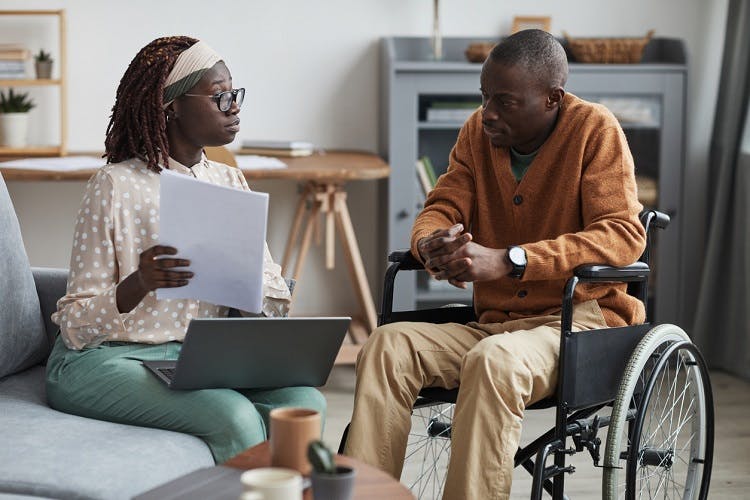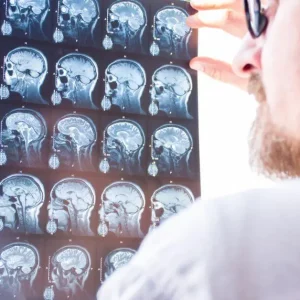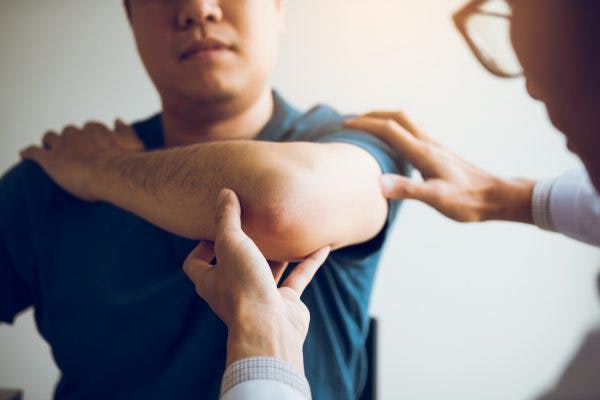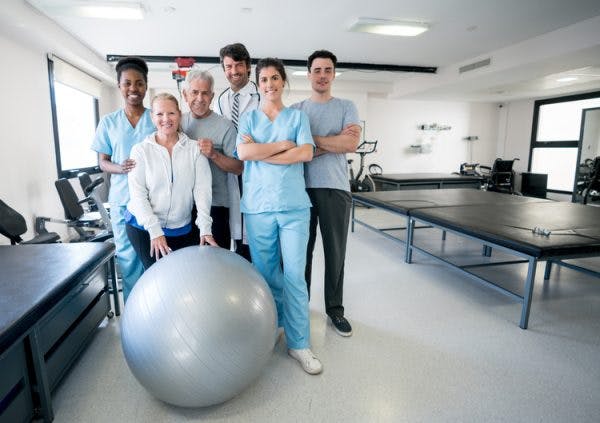When blood flow to the spinal cord is cut off or disrupted, it can result in a spinal stroke. While this condition is rare and only accounts for just over 1% of all strokes, it’s important to understand the signs and risk factors. Furthermore, it’s essential for survivors of spinal stroke to understand how the rehabilitation process works to achieve an optimal recovery.
This article will discuss some of the possible causes of a spinal stroke and treatments that can promote recovery. Use the links below to jump straight to any section:
What Causes a Spinal Stroke?
The central nervous system is comprised of the brain and the spinal cord. The brain and the spinal cord send and receive messages throughout the body through neural pathways. These messages are necessary in order to control the body and many of its functions, such as the ability to walk and talk. However, without adequate blood supply and nutrients, the transmission of these messages is disrupted.
While the brain is known as the main control center of the central nervous system, the spinal cord also plays a critical role. It transports messages between the brain and the rest of the body to facilitate movement and sensation.
A spinal stroke occurs when the blood supply to the spinal cord is disrupted, blocking the flow of oxygen-rich blood. This deprives the spinal cord of oxygen and also inhibits the transmission of nerve impulses throughout the spinal cord. Lack of oxygen-rich blood in the spinal cord can result in cell damage and death, impacting proper function. Thus, adequate blood flow is necessary in order for nerve impulses to travel effectively throughout the central nervous system.
There are two types of spinal stroke. An ischemic spinal stroke occurs when a blood clot blocks an artery, while a hemorrhagic spinal stroke occurs when there is bleeding in the spinal cord caused by a burst artery. Hemorrhagic spinal strokes are much less common than ischemic spinal strokes. It’s also worth noting that unlike other types of strokes, spinal strokes do not disrupt blood supply to the brain.
While the exact causes of an ischemic or hemorrhagic stroke vary, there are many contributing factors that can increase the risk of developing a spinal stroke, including:
- Hypertension (high blood pressure)
- High cholesterol
- Diabetes
- Smoking
- Obesity
- Lack of exercise
- Vascular malformation (abnormal connection between spinal veins and arteries)
- Aneurysm (balloon-shaped area in the artery)
- Tumor
Many of these contributing factors cause a narrowing of the arteries from plaque buildup, which suppresses blood flow. Other risk factors, such as high blood pressure, damage the arterial walls. Therefore, it’s important to practice preventative care when possible to reduce the risk of developing a spinal stroke or more serious complications.
Signs and Symptoms of a Spinal Stroke
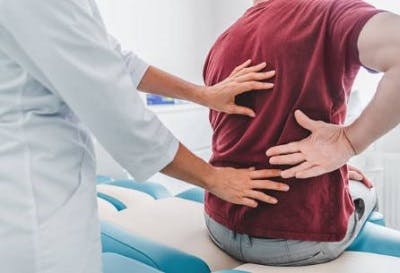
Understanding the signs and symptoms of a spinal stroke is important to help others seek emergency medical care. Timely treatment can help restore blood flow within the spinal cord as quickly as possible to help reduce the risk of severe disability or death.
Some of the most common symptoms of a spinal stroke include:
- Sharp back and neck pain
- Aching pain in the legs
- Loss of pain and temperature sensations
- Lower body weakness
- Paralysis
- Incontinence
Symptoms can appear rapidly or develop over a few hours. However, symptoms usually vary depending on what part of the spinal cord was affected or damaged. If you notice someone showing these symptoms, urge them to seek emergency medical attention. Timely treatment generally results in less severe damage and a greater potential for recovery.
Treatments for Spinal Stroke
Diagnosing a spinal stroke can be challenging because the symptoms may be similar to those of other conditions. An MRI can help distinguish a spinal stroke from other conditions because it produces a detailed image of the spine, showing the location/area of a blood clot or bleed.
However, while an MRI is considered to be the best diagnostic tool for spinal stroke, images may appear completely normal in nearly 1 out of 4 individuals with spinal stroke. Therefore, doctors may need to consider other factors to make an accurate diagnosis.
Once a spinal stroke has been diagnosed, doctors will be swift to administer treatment. Initial treatment of a spinal stroke aims to restore blood flow in the spine and prevent further complications.
Treatment depends on the type of spinal stroke. For instance, to treat an ischemic spinal stroke (caused by a blood clot), clot dissolving medication such as aspirin or tPA may be administered. Medication may also be prescribed to stabilize blood pressure or lower cholesterol. To treat a hemorrhagic spinal stroke (caused by a burst artery) emergency surgery may be necessary.
After initial treatment and stabilization, the recovery journey begins. Before discussing the rehabilitation process, it’s important to understand the potential physical and mental effects of a spinal stroke.
Secondary Effects of Spinal Stroke
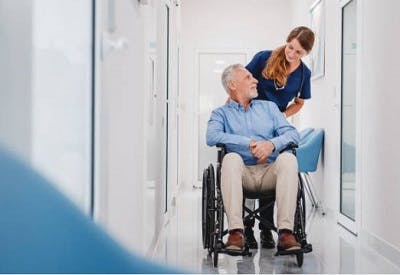
As previously mentioned, the spinal cord is essential in relaying nerve impulses that control sensation and movement throughout the body. When a stroke occurs in the spinal cord, it often results in secondary effects that impair sensation and/or movement to some degree. How much these functions are affected depends on the location (i.e. which level of the spinal cord sustained damage) and the severity of the stroke.
Each level of the spinal cord controls movement and sensation in a specific part of the body. Higher levels of the spinal cord control functions in the upper body, while lower levels control progressively lower areas of the body.
Messages cannot travel through damaged neural pathways in the spinal cord, thus functions associated with the level of injury and below are impaired. For example, a thoracic (mid-back) spinal stroke can affect movement and sensation from the mid-back and down to the legs and feet. A cervical (neck area) spinal stroke can affect movement and sensation throughout the entire body from the neck down.
Because every spinal stroke is different, every survivor will experience different secondary effects. Generally speaking, a spinal stroke only affects movement and sensation to varying degrees. However, it can also affect other functions.
Secondary effects of a spinal stroke can include:
- Loss of sensation
- Difficulty walking
- Impaired hand function
- Breathing difficulties
- Urinary or bowel incontinence
- Muscle tone problems such as spasticity (uncontrolled tightening of the muscles) or flaccidity (lack of muscle tone)
- Paralysis
- Autonomic dysfunction (difficulty regulating non-voluntary functions, such as blood pressure and bowel/bladder control)
Without proper management, other complications may occur later in recovery, such as muscle, joint, or nerve pain. Pressure ulcers may occur due to limited mobility and decreased sensation. Additionally, when a spinal stroke results in significant life changes, such as being unable to walk, daily activities and quality of life may be affected. This can lead to mental health problems, such as depression and/or anxiety.
To manage secondary effects and minimize complications, it’s essential to take action and pursue rehabilitation as soon as possible to promote recovery.
Rehabilitation After Spinal Stroke

While damage to cells in the spinal cord may not be reversible, there is hope for recovery through the process of neuroplasticity. Neuroplasticity is the central nervous system’s ability to rewire itself by creating new neural pathways and strengthening existing ones.
During a spinal stroke, some neural pathways may become damaged while others remain intact. Neuroplasticity allows these healthy, undamaged parts of the spinal cord to take on new functions in place of the damaged areas. Usually, the less severe a spinal stroke is, the more spared (undamaged) neural pathways there are. Thus, the higher the chances are of stimulating neuroplasticity and restoring function.
To stimulate neuroplasticity in the spinal cord, survivors must engage in massed practice, or high repetition of exercises. Practicing a skill repeatedly helps reinforce the importance of that skill so that the nervous system can improve it. Thus, neuroplasticity is a key element for rehabilitation.
There are different types of therapy that survivors can benefit from after a spinal stroke, such as:
Physical Therapy
In physical therapy, survivors use exercises focused on improving range of motion, strength, and mobility to stimulate the spinal cord and promote neuroplasticity. For example, survivors struggling with walking after spinal stroke can improve leg mobility by repetitively practicing leg rehab exercises.
Occupational Therapy
Occupational therapy focuses on helping individuals to restore as much functional independence as possible, while also learning how to adapt to their ability level. After a spinal stroke, many daily activities, such as dressing, bathing and eating, may become challenging.
Fortunately, your occupational therapist can prescribe exercises that directly translate to the activities of daily living. They can also recommend adaptive equipment to help you accomplish tasks independently. For example, a leg lifter can help you raise your leg into bed.
Sensory Retraining
After a spinal stroke, survivors may struggle with sensation. Some may feel a pins-and-needles sensation or numbness in the affected areas. Fortunately, studies show that sensory retraining can help individuals repair and restore the sensorimotor system. With consistent practice of sensory retraining exercises, survivors can stimulate the brain and improve sensation.
At-Home Therapy

As stated above, repetitive practice is key to promoting adaptive changes in the spinal cord for recovery. To keep yourself motivated, engaged, and practicing movements in between therapy sessions, you can use gamified, neurorehabilitation devices such as FitMi for stroke recovery.
FitMi is an interactive, home exercise program that provides full-body rehabilitation exercises for neurological recovery. It adjusts to your ability level by unlocking more difficult exercises as you improve, and also keeps track of your progress. Best of all, FitMi can be used from the comfort of your own home without any interruptions so you can practice as much as you want.
Requesting a home exercise program from your therapist is also a great way to continue promoting neuroplasticity and making improvements.
Prevention
Along with rehabilitation, it’s important to focus on prevention by avoiding the things that can increase the risk of having another spinal stroke, such as quitting smoking and managing stress. It’s also crucial to adopt a healthy diet to prevent further complications and maintain overall health. For example, eating fruits, vegetables, and whole grain foods can help improve blood pressure and cholesterol levels.
A spinal stroke can lead to a variety of effects that make life challenging. Fortunately, through therapy and lifestyle changes many survivors can recover. One study shows that about 30% of individuals could walk again with a walking aid and 40% were able to walk on their own after about 4 to 5 years of consistent rehabilitation.
Recovering from Spinal Stroke
Though a spinal stroke is not nearly as common as a brain stroke, it helps to understand what it is and how it can occur. It’s especially important to know the risk factors such as high blood pressure, diabetes, or lack of physical activity, and practice preventative care when possible. Diagnosing a spinal stroke may be challenging, but knowing what signs and symptoms to look for can help you or a loved one seek proper medical attention and treatment.
While a spinal stroke can result in various effects such as impaired mobility and sensation, there is hope for recovery through neuroplasticity. Engaging in rehabilitation such as physical or occupational therapy is essential to promote recovery.

